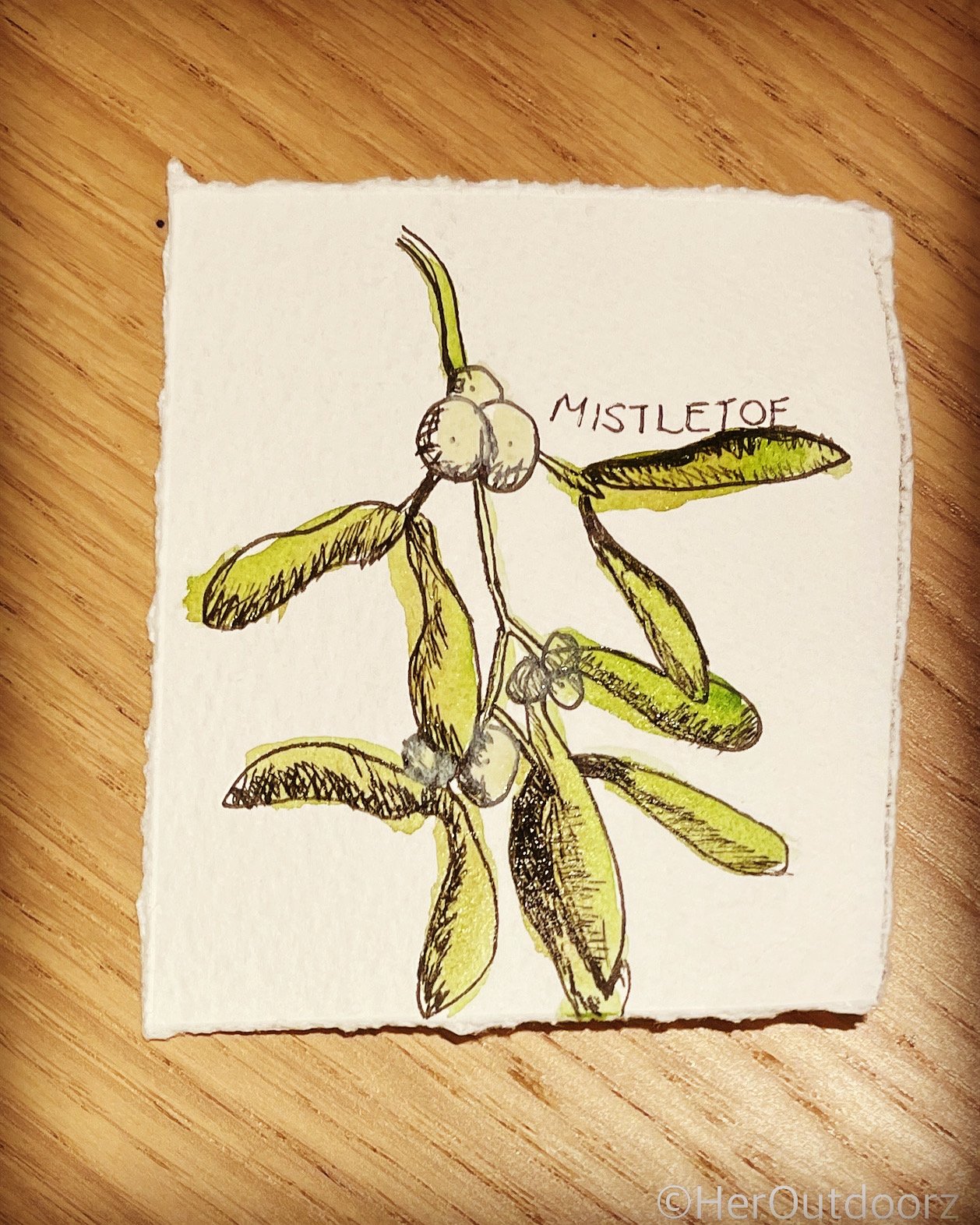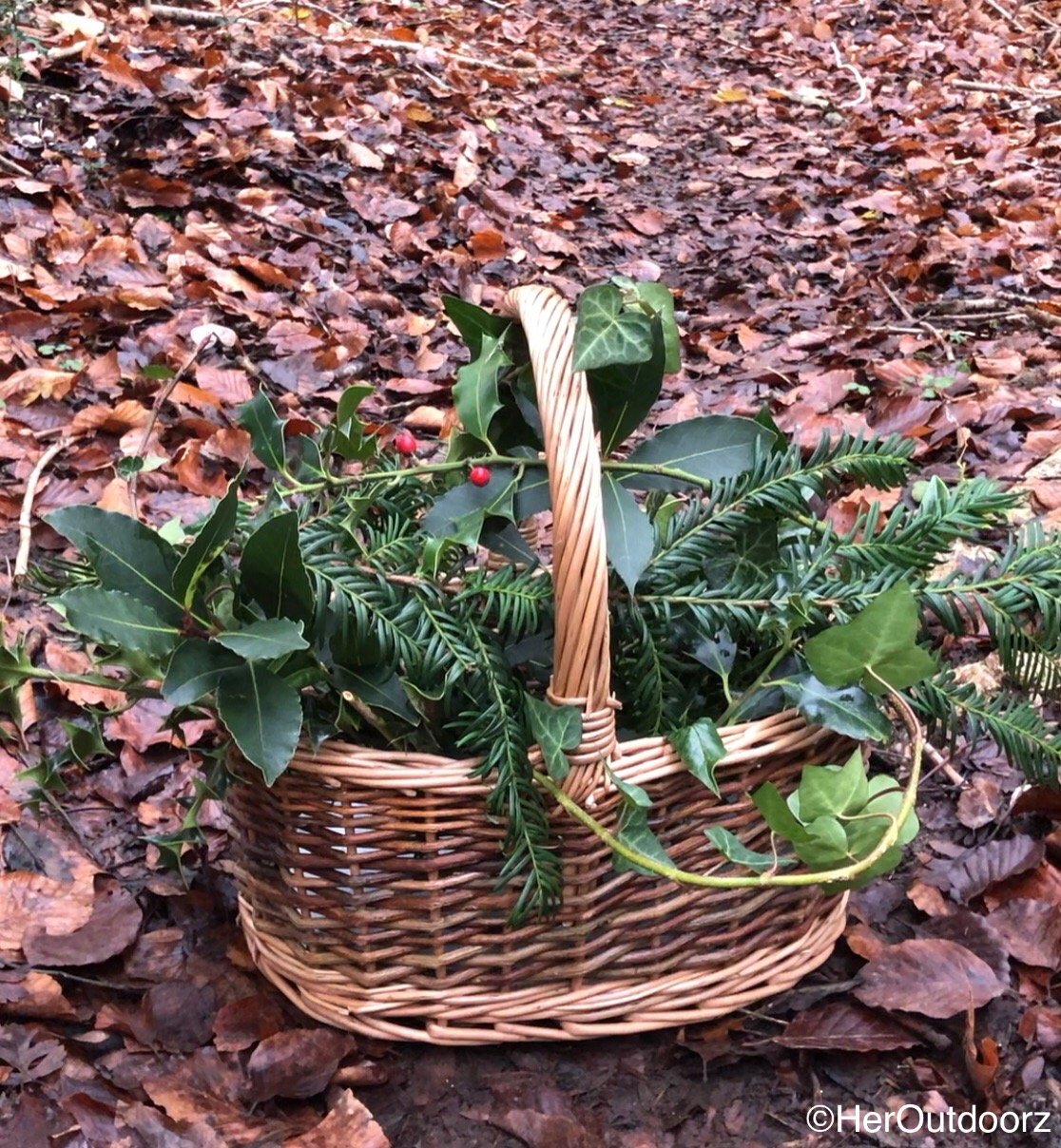Evergreens in December
Midwinter, Yule & The Winter Solstice
Midwinter falls on the 21 December. This is the shortest day of the year in the Northern Hemisphere, when the North Pole is tilted furthest away from the Sun. For centuries this date has been celebrated as a pivotal point in the year.
“This is the whole nub of the year, for if the heat and light of the sun remain absent and the dark and cold continue life here on this planet will very quickly come to an end.”
- Gillian Monks, ‘Merry Midwinter’
Many of our festive traditions derive from those early celebrations as our ancestors acknowledged the darkest days and celebrated the returning light.
The 25th of December, Christmas Day, is the first day after the Winter Solstice when we can actually measure the hours of daylight growing again, here in the Northern Hemisphere.
The Evergreens
“Now the time had come for us to go up to the woods and collect leaves for decorating the house. Among the black and bare trees we shook the snow from the undergrowth with frost reddened fingers, seeking the sharp spiked holly, bunches of laurel and ivy, cold clusters of moon pale mistletoe. With these our sisters transformed the familiar kitchen into a grotto of shining leaves, an enchanted bower woven from twigs and branches sprinkled with scarlet berries.”
- Laurie Lee, Village Christmas
For centuries people have brought evergreens inside during the darkest days of winter and every year we incorporate evergreen plants into our Christmas celebrations, almost without thinking about it.
It’s a tradition that dates to our pagan past when our ancestors revered evergreen plants., believing they were the embodiment of the spirit of life.
The plants were brought into their homes during the cold winter months. sheltering inside until the first signs of Spring - which could have been towards the festival of Imbolc, on the 1st of February.
Today we still embrace this ancient tradition of using holly, ivy and mistletoe to make Christmas wreaths, boughs and decorative trimmings in our homes. I like the idea of bringing these evergreens indoors as symbols of hope and trust that the light will return.
There’s a plethora of folklore, myth and legend associated with evergreen plants and whether or not you believe in their mystical powers, there’s a reassurance to understanding some of these ancient Christmas traditions and building on the ones you like. At the very least they offer beautiful, sustainable and recyclable natural decorations for your festive home. I’m an advocate of that!
Holly
Holly (Ilex) has plenty of folklore attached to it. In days gone by, cold howling winds in the dark nights of winter were believed to be ghosts and demons. The spiky thorns on holly hung around the front door were believed to keep homes safe from these evil spirits.
The Celts believed that two brothers the Holly King and the Oak King were locked in a terrible battle to rule the woodland. In Summer the Oak King was in full leaf and the wood bowed to his strength. But as his leaves began to drop in the Autumn, the Holly King seized the crown and ruled the Winter wood with his evergreen leaves and red berries.
In Norse mythology, Holly was associated with Thor, the god of thunder and holly plants grown by the home were thought to prevent lightning strikes.
In Ancient Rome, Holly was used to decorate the festival of Saturnalia, dedicated to Saturn, the god of agriculture and husbandry.
Ivy
In ancient Rome, ivy was associated with Bacchus, the god of wine and revelry (Dionysus in Greek mythology). This association coupled with the belief that ivy could undo drunkenness is why you can often see ivy depicted alongside bottles of wine and grapes on pub signs and adverts.
Ivy was also believed to protect and heal, bringing luck to women who carried it with them. It was used in fidelity and love charms and brides getting married in the winter held a bouquet of ivy, mistletoe and holly to promote fidelity, long life and protection from the Gods.
FACT: If you are lost in dense woodland and need to get out, head towards trees covered in ivy. Ivy likes to grow near the edges of old forest and woodlands.
Ivy used to be forbidden as decor by Christians who thought its ability to grow in shade, led to an association with secrecy and debauchery!
Now the infamous festive pairing of holly and ivy is widely accepted in Christian practice. It’s honoured with its own Christmas carol written in the early 1800s and based on the medieval practice of decorating houses with holly and ivy to celebrate the winter solstice, as well as Christmas.
“The holly and the ivy,
When they are both full grown,
Of all the trees that are in the wood,
The holly bears the crown.
The rising of the sun
And the running of the deer,
The playing of the merry organ,
Sweet singing in the choir.”
The later verses of the carol are based on Christian culture - the thorns of the holly represent the thorny crown worn by Jesus, the red berries symbolising Jesus’s blood and the ivy representing the Virgin Mary.
Mistletoe
Mistletoe appears in the canopy of trees looking like clouds caught among the branches.
It’s an ancient plant whose name derives from the Old English misteltãn and it’s surrounded by myth and tradition associated with romance and fertility.
Botanically, Mistletoe (Viscum) is an interesting plant, growing in the canopy of other trees and having no roots or links to the earth itself. It’s a parasite, drawing nutrients from the host plant. Historically, Mistletoe was thought to encourage fruiting in orchard trees and was deliberately spread to increase fruit production. Apple is the most common host species, but it is also found on limes, hawthorn and poplar.
The ancient Greeks believed the mistletoe plant had offended the Gods who condemned it to look on while pretty girls were being kissed beneath it!
In Norse mythology, there’s a different telling of this story. Much loved god Balder was kept from harm by his mother Frigga, goddess of love and beauty. She secured promises from the elements that anything they grew from the Earth would not harm Balder. The loophole was parasitic mistletoe and when Loki found out he crafted a mistletoe arrow which was used to kill Balder. Frigga's tears became the mistletoe's white berries. There’s a happy ending version of the story in which Balder is restored to life and Frigga gratefully makes mistletoe, a symbol of love bestowing the promise of a kiss upon anyone who passes under it.
The Ancient Druids believed mistletoe to be very sacred. At the winter solstice (called 'Alban Arthan' by the Druids) the Chief Druid would cut the sacred mistletoe from the Oak tree using a golden sickle, on the sixth night of the new moon after the winter solstice. A cloth held below the tree was used to catch the mistletoe, preventing it from landing on the ground. He then divided the mistletoe into sprigs to be hung over doorways, as protection against thunder, lightning and other evils.
The Celts believed that mistletoe was a healing plant and its country name is Allheal. Traditionally used to cure many ills it has now been discovered to contain anti-tumour compounds. However, mistletoe can be toxic when ingested so don’t use it without expert advice.
So, when you put up your wreaths of holly and ivy and kiss under the mistletoe remember you are taking part in ancient traditions!
For more inspiration on decorating your home with seasonal evergreens and a sprinkle of bling have a watch of this jolly little film I made with my artist friend Jenny Muncaster.
I’d love to hear how you get on adding that little bit of bling.
Do get in touch by emailing me at nicola@heroutdoorz.co.uk
Post your photos using the hashtag #wildseasonalinspiration so I see them.
Grow Your Own Evergreenery
I know your garden probably isn’t front of mind now. What with the less-than-inviting weather, the shorter hours of light and the tempting sparkly lights of Christmas to lure you away! But evergreens are your winter friends, providing interest in the garden, your own supply of winter decoration and shelter for wildlife to over winter. Why not embrace the ancient symbolism of holly and add one to your garden – they offer more than just festive red berries and evergreen leaves!
Holly is easy to grow preferring moist but well drained soil and needs minimal pruning. It can be in sun or partial shade although the variegated varieties keep their colours better in full sun. If you plant a fruiting variety in your garden the birds will thank you for adding such an important source of winter food.
Top Tip: If you are cutting holly for festive decorations, pick some early in winter before the berries get eaten by birds. Always leave some for the hungry birds!
Holly is dioecious, meaning you generally need both a male AND a female plant for the female plants to produce red berries. Only the females produce berries. Our common holly, Ilex aquifolium, is dioecious and gets big so allow plenty of space. There are lots of varieties, some of which have variegated leaves.
Here are some varieties to consider:
Ilex aquifolium ‘J.C. van Tol’ is a self-fertile, female variety (so you only need one holly for berries) with smooth leaves and red berries which grows to about 5m.
Ilex aquifolium 'Silver Queen' is grown for its distinctive foliage, with silver edges on the spiny and glossy green leaves. It’s a large, male plant so does not produce berries but the stems and young foliage are purple.
Ilex x altaclerensis 'Golden King' is a pretty golden variegated holly. It is relatively compact, with a conical shape. It's a female variety, produces red berries in autumn and its leaves are less spiny than traditional holly.
Ilex x aquipernyi Dragon Lady is a small tree or shrub of dense, narrow columnar habit with dark shoots, smaller, spiny leaves and red berries
Ilex aquifolium 'Hascombensis' This unusual male holly is compact and slow growing with small, pointed leaves. It’s recommended by BBC Gardener’s World for growing in a pot.
December Moon
We’re reaching the darkest points of the year the time when the nights are long and the days are short. If there’s an upside then perhaps it’s that the moon really shows up at this time of year.
The December moon is called the Cold Moon, Full Cold Moon, Wolf Moon, Long Night Moon, Oak Moon and Big Winter Moon.
December is a time to rest, in the dark and quiet. Time to regroup, regain strength and reinforce your inner resources. It’s also a time for looking back and seeing how far you’ve come and what you need to get where you want to be.















The quieter, short days of winter often drag and January can seem very long. Outdoors the natural world has surrendered to the cold and dark and life has retreated to the relative warmth underground. We have to look harder for the uplifting glimmers. The things that bring joy and optimism.